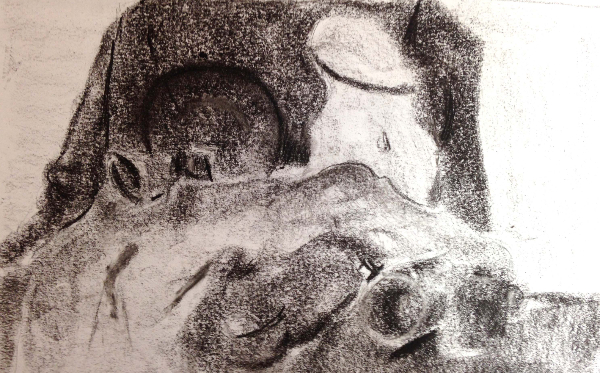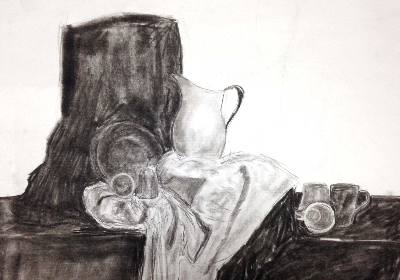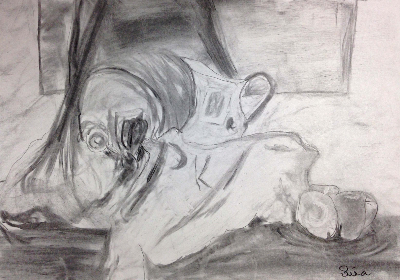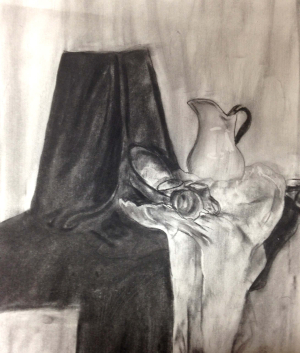8. 26. 2015
Fall semester begins at Rocky Mountain College. I am teaching drawing to students who are mostly non-art majors. They are from a wide range of backgrounds, studying many different things and with little to no experience drawing (yes, I am talking about you-- hello there my students from Rocky, so glad you joined our discussion) Today I want to talk about what drawing can do for the artist and non-artist alike. To start this discussion I did a little research, read and asked people why they draw. Each person was very specific about what drawing meant to them but the reasons were actually very similar. A friend also sent articles on the topic of drawing and I included them in this discussion. I do try to keep my newsletter short so here are the three reasons why drawing is important for everyone:
1. Drawing improves visual communication skills.
A simple sketch can sometimes make an idea clearer than a hundred words, and stands a good chance of being understood and remembered. Drawing is widely used within a range of other professions as a means to develop, document, explore, explain, interrogate and plan. This includes the fields of science, technology, engineering, mathematics, medicine and sport. Are you familiar with the saying, "A picture is worth one thousand words?" An image is valuable because it can transcend the barriers of verbal language, and enhance communications in an increasingly globalized world.
2. Drawing strengthens critical thinking skills and helps you become a better whole brain thinker.
Learning something new engages the brain and helps keep your mind sharp. Learning how to draw also involves fine tuning psychomotor skills. Capturing an image onto paper is not just intellectually demanding, it involves learning how to make the muscles in your hand guide the pencil in the right directions. Read more about this idea and other ways to prevent memory loss by clicking: http://www.bbc.com/news/magazine-33505017
3. Drawing is fun.
When you draw you can see more than when you don't, it is like having a super power. Overtime you begin to deepen your experience with the world around you. You become more observant and it can help you visualize something and think differently. Drawing helps to improve creativity, which is the ability to make new things, think of new ideas.
#3 is my personal favorite. Expanding my understanding of drawing has created a whole new way of looking and doing things. It has helped to rekindle my creative spark, I don't look, dress, cook the same -- I don't even go to the same grocery store anymore! Sometimes during the life drawing session at MSUB (on Thursdays @ 7pm) I don't even recognize my own artwork, it has changed so much. I observed habits forming in all areas of life and changing the way I looked at things has helped in my ability to embrace change in other areas as well. Ok, maybe this idea sounds a little exaggerated, but I do think there is a connection.
Who knew drawing could have such effects?
Cezanne, Still Life with Apples
Isn't color dazzling? Our response to color can be so strong that sometimes new students overlook the other important elements in a piece of artwork. So for the purpose of gathering a richer understanding of why this painting works, we will study it as a black&white image.
This week I am interested in composing a simple still life. I am studying the work of Cezanne, and have learned arranging objects in a still life is much more interesting than you would expect. In class on Wednesday we begin by looking at the painting Still Life with Apples by Cezanne. We discuss the work as a black+ white image. Without the element of color, it is easier to look at how the other elements such as shape, edges and composition are use.
After spending time discussing the painting, we put it away and use our visual memory to recreate a similar still life in class using objects found in the studio. The lesson this week is about composition and shape, we are studying the relationship between shapes and not rendering exact objects. Objects should have a similar shape and proportion to the forms in the painting, but they don't have to be exact! A group of mugs can easily be substituted for a bunch of apples. My students draw from the still life using their own interpretations. In a series of thumbnails students work out the relationships between shapes and composing them best within a format. We talk about how composition goes beyond drawing objects to thinking about the whole pattern and considering the entire piece of paper.
This is an example of how students learn to think about composition using thumbnails.

Here are a few photos of my student's work







